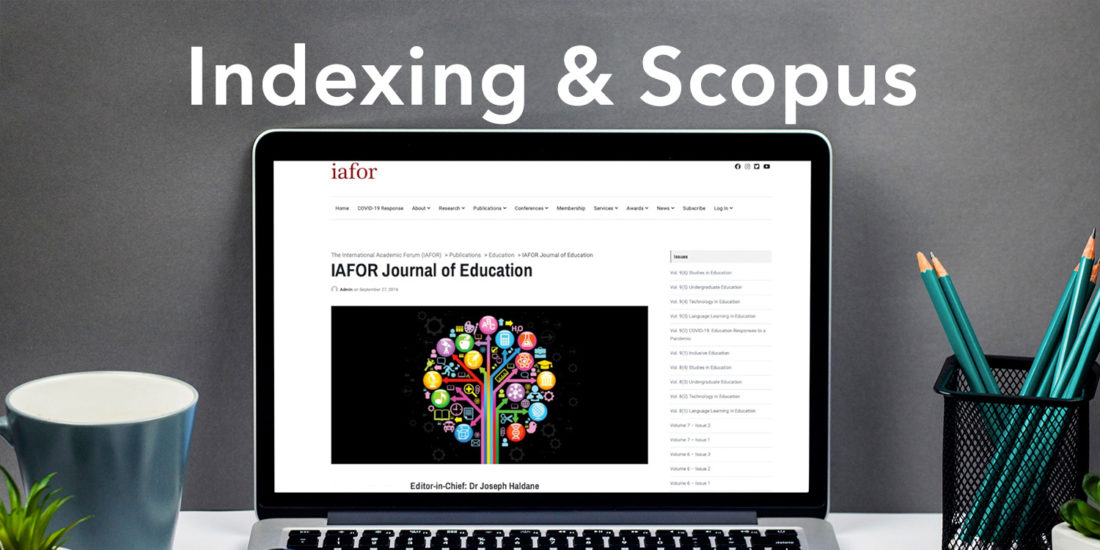One of the most frequent questions that we are asked about the IAFOR Journal of Education is whether it is indexed with Scopus. It is: we were granted Scopus indexing mid-2019. But what does this mean? Why should journals want to be indexed? And why Scopus? The IAFOR Journal of Education is currently indexed in 17 places including Scopus, SJR, DOAJ, ERIC, WorldCat, ULRICHSWEB and EBSCO among others. The more widely a journal is indexed, the more likely it is to be available in library databases: this means that your published articles have a higher chance of being found, read, and, hopefully, cited. Each indexing agency reaches a slightly different audience, further widening journal exposure.
In terms of Scopus, full database access requires a subscription: its data are not freely shared (SCImago is an exception). On the other hand, DOAJ makes almost everything freely available and offers an open API (application programming interface). This means other indexers can use DOAJ data to populate their indexes. A DOAJ listing for a journal means its metadata is also indexed in ROAD, MIAR, TROVE, Scilit, Mir@bel, LENS.ORG, ScienceGate, Dimensions, and scite. After publishing an issue, some of the indexers require the submission of metadata and DOIs, while other indexers crawl the website to retrieve this information for themselves.

But why the hype about Scopus?
Interestingly, it is rare to be asked whether the journal is indexed with anyone other than Scopus. Occasionally, American authors might enquire about ERIC (Education Resources Information Center, from the U.S. Department of Education). Perhaps if we were a medical journal, more would ask about Web of Science or PubMed, but as an education journal it is Scopus. This is largely because the academic world of education has given importance to this particular index. Many universities favour Scopus when their academics seek promotion and present their publication record. Hence, authors seek journals with this indexing. Demand has, in some ways, led to its preferred status in this field. But there is a sound reason behind what might seem an arbitrary choice of indexing agency: academic rigour.
Academic rigour
One among many, Scopus is an “abstract and citation indexing database of peer-reviewed literature: scientific journals, books and conference proceedings” owned by the Elsevier publishing firm (Elsevier, https://www.elsevier.com/en-au/solutions/scopus). This description provides a first clue to its academic rigour: it requires peer review to be an integral component of anything indexed with it. There are also many other requirements that must be met by any journal seeking indexing. Some of these requirements are:
-
- diversity in the geographical location of editors and authors;
- academic contribution to the field;
- quality of content;
- publishing regularity.
The selection requirements can be found in full at https://www.elsevier.com/solutions/scopus/how-scopus-works/content/content-policy-and-selection.
In addition to meeting these requirements for initial indexing, to monitor journal quality, Scopus runs an ongoing re-evaluation program which identifies outlier and underperforming journals. Thus, it behoves any indexed journal to also maintain academic rigour in the articles that it accepts. Journals are also evaluated on their citation statistics: it is important that published articles are cited.
Where to find CiteScore and articles on Scopus
Scopus Preview offers free journal ranking information and metrics to non-subscribers. Scopus also offers a free profile to all indexed authors who need to review, claim and update their profiles. The Scopus CiteScore measures average citations received per document published in the journal. It is useful for comparing journals within the same field, ranking them in subject categories and indicating the percentile they fall into. Scopus Preview for the IAFOR Journal of Education, containing the latest CiteScore Tracker, citations and documents indexed to date, is here: https://www.scopus.com/sourceid/21100913652. Scopus Preview also shows the SCImago Journal Rank (SJR) which measures citations weighted by prestige. It is useful for comparing journals within the same field and forms the basis of the subject category ranking.
So only Scopus indexed journals are reputable!
Because Scopus is currently the leading indexing database preferred by a good number of universities, there is a belief that only Scopus indexed journals are reputable. This is not the case. There are many journals that are not registered with Scopus, for a range of reasons, but they are reputable journals following good academic publishing practices. Also, other multidisciplinary databases such as Web of Science or ProQuest Central are similarly rigorous in their selection criteria.
As authors, you still need to consider placing your article in journals where the aims and scope mesh with your topic. If you are in a very new field, you may be hard pressed to find a journal indexed with Scopus as this is a two-year minimum process: at least three published issues are examined in the selection process which may take a further two years. Furthermore, manuscript submissions to Scopus journals tend to be heavy and the publication process highly competitive and sometimes lengthy. There are predatory journals out there, but not all non-Scopus indexed journals are predatory. In the field of education, if a journal is indexed by DOAJ and ERIC, then that is a mark of quality in its own way; it means particular standards have been met and your work is also widely distributed in library databases throughout the world.
We hope that this has explained a little more about indexing and the IAFOR Journal of Education.
Yvonne
Dr Yvonne Masters
Executive Editor, IAFOR Journal of Education


